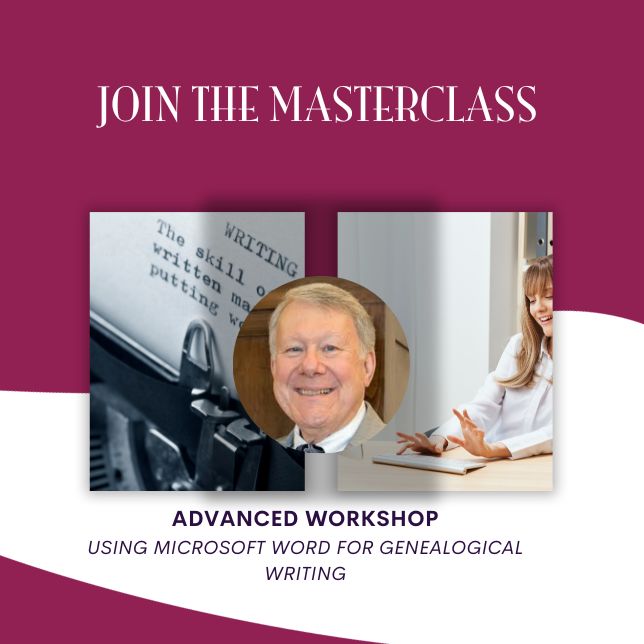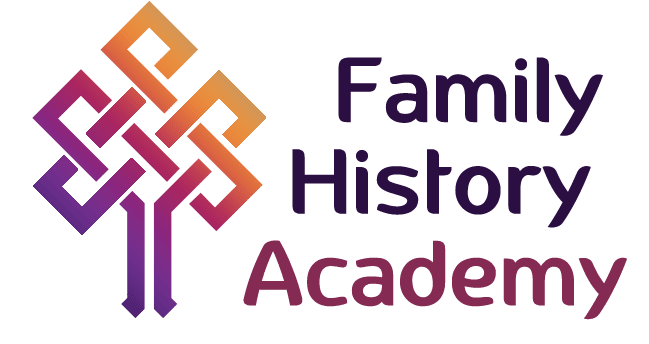No products in the cart.
Masterclass with Tom Jones
Advanced Genealogical Writing Skills using
Microsoft Word

Take your writing skills to the next level!
Many of us rely on Microsoft Word for genealogical writing, often sticking to its essential features. But did you know that making informed choices about your document's setup can significantly impact how peers or family members perceive your work?
This masterclass is designed to provide you with the knowledge, skills, and insights necessary to advance your Microsoft Word expertise. The best part? The masterclass offers a unique opportunity to enhance your skills under the guidance of Tom Jones, one of the profession's most respected educators. Renowned for his innovative approaches to researching and writing, he has significantly influenced how we create meaningful and accurate family histories.
Masterclass details
Note: Price is in US dollars.
Dates, times and cost
Each module is 3 hours (1.5 hours per session x 2).
COST: $235
Module 1. Focus on Styles
12 and 19 March 2024 @ 7.30pm Eastern
Module 2. Focus on Page Layout, including Paragraphs, Margins, Headers, and Footers
9 and 16 April 2024 @7.30pm Eastern
Module 3. Focus on Tables and Figures
30 April and 7 May 2024 @7.30pm Eastern
All Zoom sessions are closed captioned, recorded and available for viewing for 14 days following the session. Handouts are included.
Attendance is limited to 30 participants.
Modules
Each module has two parts. In Part One (week 1), you will learn how to create, modify and apply a particular tool/function of Microsoft Word and then apply it in an in-class exercise. You are given the opportunity during the week following Part One to create your own document styles (the ‘house’ style) and apply them to a genealogical writing sample of your choosing.
In Part 2 (week 2), if you choose to, you share how you created your “house” style, for example, the structure and layout of tables, and applied it to your genealogical writing sample(s). Your own and others’ examples will be discussed with instructor feedback given.
If you are ready to take your skills to the next level, then one or more of these modules will be for you.
Module 1: 12 and 19 March 2024
Focus on Styles
In this module, you will learn how to create, apply and modify a variety of Word style types to help save time when creating consistent and well-designed documents.
You will:
- Understand the importance of styles and their application to your genealogical writing
- Understand the difference between paragraph and character styles
- Create, modify and locate your own styles
- Explore methods for copying styles from one document to another
- Generate and modify a table of contents using styles
- Use keyboard shortcuts for your own styles.
Module 2: 9 and 16 April 2024
Focus on Page Layout, including Paragraphs, Margins, Headers, and Footers
Words, and how we put them together, matter but the document’s visual features—design, layout, paragraphing, and other organizational elements—are key to how others view our writing. They also keep our documents organised and easier to read, helping us accomplish our reasons for writing.
In this module, you will:
- Use different type sizes, weights, and styles to create your own typographic hierarchy
- Develop typographic options for separating paragraphs
- Know how to insert up to four levels of subheads in genealogical writing
- Understand the different ways in which you can view your work–Print Layout, Web Layout, Outline, and Draft.
- Learn about the optimal size and format for document margins and how to make modifications based on the type of document
- Know when, and how, to incorporate “running” headers and footers
- Understand the difference between page numbering options for front matter (table of contents, for example) and general writing
- Know how to change from one numbering style to another.
Module 3: 30 April and 7 May 2024
Focus on Tables and Figures
Tables organise and present information while figures provide a visual addition to a document. When added to a case study, research report, journal article, blog post or other types of writing, tables and figures can improve the readability of a document.
In this module, you will:
- Learn how to insert and edit tables and figures
- Add captions to tables and figures
- Convert text to tables and vice versa
- Create and apply custom table styles.

About the educator
Thomas W Jones, PhD, CG®, FASG, FUGA, FNGS
Tom Jones co-edited the National Genealogical Society Quarterly for sixteen years. He has written the textbooks Mastering Genealogical Documentation and Mastering Genealogical Proof, twenty-eight articles in peer-reviewed and edited genealogy journals and twenty-six more articles in genealogical magazines and newsletters. A holder of two graduate degrees in education, he teaches online and in-person at genealogical institutes and seminars locally, regionally, nationally, and internationally. Audiences and students consistently report learning much from his lectures and interactive classes.

